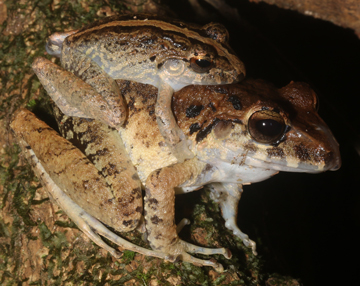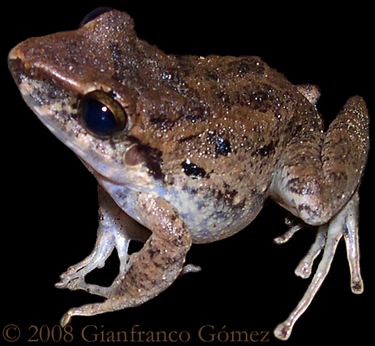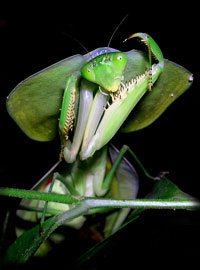|
Discover the
hidden treasures of Drake Bay, Costa Rica with Tracie "The Bug Lady"

Home

Tour
Basics

Meet the Bug
Lady

Tales from the
Edge

Media

Reservations

Links



Facts about Drake Bay, Costa Rica

Travel To Drake Bay

Drake Bay Area Map

Hotel Information

Tips for Travelers

Tours

Recommended
Reading





|
|
|
A Night Tour would not be
complete without encountering a Common Rain Frog. This is by far the most common nocturnal frog in Drake Bay.

They
are medium sized frogs, and adults measure between 23 and 53
millimeters. As with most frogs, females are much larger than males.
Males are very vocal and can be heard calling sporadically
throughout the night, much more frequently during the rainy season.
Their advertising call has
been described as a series of "clacks", resembling two small rocks
being struck against one another. Males will respond to other
calling males as well as to humans imitators. This makes locating
these frogs a much easier task. It seems that males respond to other
calls with a much shorter and harsher cackle, possibly a territorial
call. Males seem to be quite territorial and we have had several
irate frogs approach us frantically when we call out to them. |
|
 Coloration
and color patterns may be quite variable within this species. Some
individuals have a stripe running down their back, some have spots,
while others have a solid color. Coloration may range from gray to
brown and anywhere in between. Coloration
and color patterns may be quite variable within this species. Some
individuals have a stripe running down their back, some have spots,
while others have a solid color. Coloration may range from gray to
brown and anywhere in between.
This has led to much
confusion and many misidentifications of these frogs by researchers
throughout the years.
Even with all of these
variations, they do have a few distinguishing characteristics. A
pattern of yellow spots overlaid on a dark background located on the
back of the thighs and a diffuse white line running down the middle
of their throat are diagnostic. Their call is also diagnostic. Since
females don't call, though, this is only useful in identifying
males. |
|
 Despite
being so abundant, Common Rain Frogs have proven to be something of
an enigma for scientists. The first recorded discovery of their nest
dates back to June 2, 1931. Dunn found a nest with 44 eggs laid on the
ground, underneath leaf litter. There was an adult frog, probably a
female, guarding the egg clutch. Despite
being so abundant, Common Rain Frogs have proven to be something of
an enigma for scientists. The first recorded discovery of their nest
dates back to June 2, 1931. Dunn found a nest with 44 eggs laid on the
ground, underneath leaf litter. There was an adult frog, probably a
female, guarding the egg clutch.
Incredibly, this was the
only recorded egg clutch found by scientists for over 70 years!
During these 7 decades researches pursued, unsuccessfully, their
quest for the common rain frog's egg clutch. A thirteen month study of the
leaf litter carried out at La Selva Biological Station failed to
reveal any nests. |
|
 In
2002, 71 years after the first nest was discovered, Mendoza found a
second Common Rain Frog nest on the ground with 85 eggs and a female
frog guarding them. The embryos in this species go through
direct development inside the egg. They never have a free swimming
tadpole stage and tiny, fully formed frogs emerge from the
eggs. In
2002, 71 years after the first nest was discovered, Mendoza found a
second Common Rain Frog nest on the ground with 85 eggs and a female
frog guarding them. The embryos in this species go through
direct development inside the egg. They never have a free swimming
tadpole stage and tiny, fully formed frogs emerge from the
eggs.
Common
Rain Frogs are known to exist in humid zones of Honduras, Nicaragua,
Costa Rica, Panama, and Colombia. |
|
|
|
The Frog
Files





     






 |



 Alien Earthlings
Alien Earthlings  The
Dark Side
The
Dark Side






 Coloration
and color patterns may be quite variable within this species. Some
individuals have a stripe running down their back, some have spots,
while others have a solid color. Coloration may range from gray to
brown and anywhere in between.
Coloration
and color patterns may be quite variable within this species. Some
individuals have a stripe running down their back, some have spots,
while others have a solid color. Coloration may range from gray to
brown and anywhere in between.
 Despite
being so abundant, Common Rain Frogs have proven to be something of
an enigma for scientists. The first recorded discovery of their nest
dates back to June 2, 1931. Dunn found a nest with 44 eggs laid on the
ground, underneath leaf litter. There was an adult frog, probably a
female, guarding the egg clutch.
Despite
being so abundant, Common Rain Frogs have proven to be something of
an enigma for scientists. The first recorded discovery of their nest
dates back to June 2, 1931. Dunn found a nest with 44 eggs laid on the
ground, underneath leaf litter. There was an adult frog, probably a
female, guarding the egg clutch.
 In
2002, 71 years after the first nest was discovered, Mendoza found a
second Common Rain Frog nest on the ground with 85 eggs and a female
frog guarding them. The embryos in this species go through
direct development inside the egg. They never have a free swimming
tadpole stage and tiny, fully formed frogs emerge from the
eggs.
In
2002, 71 years after the first nest was discovered, Mendoza found a
second Common Rain Frog nest on the ground with 85 eggs and a female
frog guarding them. The embryos in this species go through
direct development inside the egg. They never have a free swimming
tadpole stage and tiny, fully formed frogs emerge from the
eggs.







